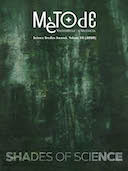The future of biodiversity on Earth: The importance of preserving the phylogenetic and functional diversity of the planet
DOI:
https://doi.org/10.7203/metode.10.14601Keywords:
global change, biodiversity loss, conservation, evolutionary rescue, flexible rescue Abstract
Abstract
The extraordinary biodiversity of Earth is currently threatened by the destruction of natural habitats, climate change, invasive species, and overexploitation. More and more, ecologists are starting to recognise that preserving the maximum number of species is insufficient. If we want to preserve functional ecosystems for the future and continue to enjoy their benefits, we must also protect phylogenetic and functional diversity. But to do this, it is not enough to delimit protected areas, we must also learn to combine the exploitation of resources with the preservation of key elements of biodiversity that guarantee the stability and functioning of ecosystems.
 Downloads
Downloads
 References
References
Alberti, M., Marzluff, J., & Hunt, V. M. (2017). Urban driven phenotypic changes: Empirical observations and theoretical implications for eco-evolutionary feedback. Philosophical Transactions of the Royal Society B: Biological Sciences, 372(1712), 20160029. doi: 10.1098/rstb.2016.0029
Bell, G. (2017). Evolutionary rescue. Annual Review of Ecology, Evolution, and Systematics, 48, 605–627. doi: 10.1146/annurev-ecolsys-110316-023011
Cook, L. M., Grant, B. S., Saccheri, I. J., & Mallet, J. (2012). Selective bird predation on the peppered moth: The last experiment of Michael Majerus. Biology Letters, 8(4), 609–612. doi: 10.1098/rsbl.2011.1136
Díaz, S., & Cabido, M. (2001). Vive la difference: Plant functional diversity matters to ecosystem processes. Trends in Ecology and Evolution, 16(11), 646–655. doi: 10.1016/S0169-5347(01)02283-2
Ferraz, G., Russell, G. J., Stouffer, P. C., Bierregaard, R. O., Pimm, S. L., & Lovejoy, T. E. (2003). Rates of species loss from Amazonian forest fragments. Proceedings of the National Academy of Sciences, 100(24), 14069–14073. doi: 10.1073/pnas.2336195100
May, R. M. (2010). Tropical arthropod species, more or less? Science, 329(5987), 41–42. doi: 10.1126/science.1191058
Sinclair, A. R. E., Mduma, S. A. R., Hopcraft, J. G. C., Fryxell, J. M., Hilborn, R., & Thirgood, S. (2007). Long-term ecosystem dynamics in the Serengeti: Lessons for conservation. Conservation Biology, 21(3), 580–590. doi: 10.1111/j.1523-1739.2007.00699.x
Sol, D., Bartomeus, I., González-Lagos, C., & Pavoine, S. (2017). Urbanisation and the loss of phylogenetic diversity in birds. Ecology Letters, 20(6), 721–729. doi: 10.1111/ele.12769
Sol, D., Duncan, R. P., Blackburn, T. M., Cassey, P., & Lefebvre, L. (2005). Big brains, enhanced cognition, and response of birds to novel environments. Proceedings of the National Academy of Sciences of the United States of America, 102(15), 5460–5465. doi: 10.1073/pnas.0408145102
Sol, D., Maspons, J., Vall-llosera, M., Bartomeus, I., Garcia-Peña, G. E., Piñol, J., & Freckleton, R. P. (2012). Unraveling the life history of successful invaders. Science, 337(6094), 580–583. doi: 10.1126/science.1221523
Tilman, D. (1997). The influence of functional diversity and composition on ecosystem processes. Science, 277(5330), 1300–1302. doi: 10.1126/science.277.5330.1300
Tittensor, D. P., Walpole, M., Hill, S. L. L., Boyce, D. G., Britten, G. L., Burgess, N. D., ... Ye, Y. (2014). A mid-term analysis of progress toward international biodiversity targets. Science, 346(6206), 241–244. doi: 10.1126/science.1257484
Whitman, K., Starfield, A.M., Quadling, H. S., & Packer, C. (2004). Sustainable trophy hunting of African lions. Nature, 428, 175–178 doi: 10.1038/nature02395
Downloads
Published
How to Cite
-
Abstract1500
-
PDF696
Issue
Section
License
![]()
All the documents in the OJS platform are open access and property of their respective authors.
Authors publishing in the journal agree to the following terms:
- Authors keep the rights and guarantee Metode Science Studies Journal the right to be the first publication of the document, licensed under a Creative Commons Attribution-NonCommercial-NoDerivatives 4.0 International License that allows others to share the work with an acknowledgement of authorship and publication in the journal.
- Authors are allowed and encouraged to spread their work through electronic means using personal or institutional websites (institutional open archives, personal websites or professional and academic networks profiles) once the text has been published.





